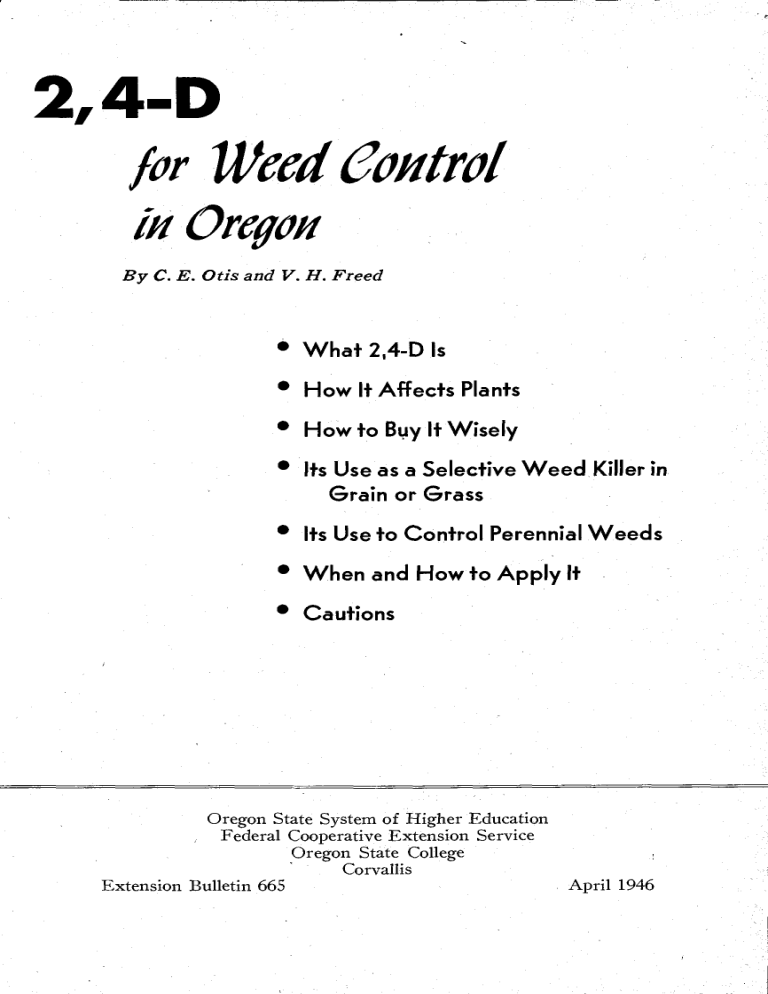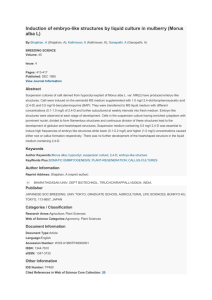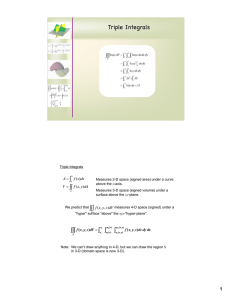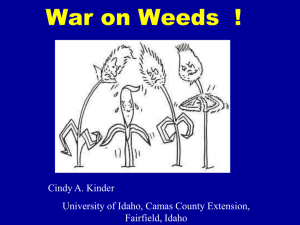2,4-D for Weed Cootrol Oregom

2,4-D
for
Weed Cootrol
Oregom
By C. E. Otis and V. H. Freed
What 214-D Is
How It Affects Plants
How to Buy It Wisely
Its Use as a Selective Weed Killer in
Grain or Grass
Its Use to Control Perennial Weeds
When and How to Apply It
Cautions
Oregon State System of Higher Education
Federal Cooperative Extension Service
Oregon State College
Corvallis
Extension Bulletin 665 April 1946
2,4-D
For Weed Control in Oregon
By
C. E. OTIS and V. H. FREED* there is little or no truth to the belief seemingly sary only to step out into the field and speak, in a clear, firm voice, the three magic letters, "2,4-D." This organic acid, belonging to that group of interesting chemicals known as growth regulators, is not yet the panacea for all weed ills.
On the other hand, while it is the youngest member in the big family of weed killers or herbicides, it is already one of the most important and certainly the most talked about.
Early experimental work done in England and by the U. S. Department of Agriculture and others on the East Coast brought this material to light in 1944.
From then on it grew faster than Jack's beanstalk, until today there are at least forty commercial 2,4-D preparations on the market.
Experiment stations everywhere are operating under "forced draft" in an attempt to answer the many questions that stand in the way of complete use and unqualified recommendation.
HOW 2,4-D AFFECTS PLANTS
It is the strange chemical's peculiar individuality that is causing researchers' hair to gray prematurely. Most weed killers are fatal to plants on contact, usually through a caustic type of action, but not 2,4-D.
It moves rapidly into position within the plant after which it slowly and insidiously tortures and starves the weeds to death.
Often six or eight weeks will elapse after treatment before susceptible plants die down completely.
The first symptom is a
twisting and bending of stems and leaves, often followed by swelling, cracking, and splitting of the stems ; or the tops may dry gradually and die.
Seriously affected plants may develop enlarged and spongy roots with the outer part sloughing away.
WHAT IS 2,4-D?
Although the original or parent acid is a white powder that will not dissolve in water, the commercial 2,4-D preparations offered for
"Assistant Extension Specialist in Farm Crops, and Assistant Agronomist, Oregon
Agricultural Experiment Station, respectively.
2,4-D FOR WEED CONTROL sale have been processed to make them water soluble. These products appear on the market in three forms : as liquids, powders (salts), and tablets (also salts).
2,4-D is not particularly poisonous, corrosive, or inflammable although human beings may be allergic to the chemical and certain carriers used in some commercial compounds could be harmful.
BE A WISE SHOPPER
Weed killers sold in Oregon must have a declaration of active ingredients appearing on the label.
In the case of 2,4-D materials, the active ingredient is the parent acid or a derivative thereof and is the only part of the mixtures having weed killing properties.
The liquid preparations, usually weighing 8 to 81 pounds per gallon, vary in active ingredient content from 9.6 per cent to 40 per cent.
The powders range in content of parent acid between 30 per cent and 85 per cent, while the tablets analyze between 30 per cent and 60 per cent of actual 2,4-D acid.
Experimental evidence to date has shown little practical difference in effectiveness among the various brands on dealers' shelves provided the same amount of parent acid or its derivative is applied to equal areas in each case.
Also, one is about as easy to mix with water and use in a sprayer as another. The choice of 2,4-D material should then be based on cost, and to determine comparative costs one must compare both purchasing prices and analyses of active ingredients.
For example, to determine the cost of the active ingredient in any 2,4-D compound, divide the cost per pound by the percentage of active ingredient.
To illustrate : Suppose a salt contains 60 per cent of 2,4-D acid and costs $2.10 per pound while a liquid contains 9.6 per cent acid and costs $4 per gallon :
3.50
.60 / 2.10
The parent acid in the salt costs
$3.50 per pound.
The liquid, costing $4 a gallon, weighs about 8 pounds per gallon and costs, therefore, 50 cents per pound of liquid, so to find cost of acid in the liquid divide the 50 cents by 9.6 per cent :
5.21
.096 / .50
The parent acid in the liquid
costs $5.21 per pound.
Because concentrations of the various commercial products differ so much, dosages recommended later in this bulletin are given in pounds of parent acid per acre.
By using the following table, it is
4
EXTENSION BULLETIN 665 easy to determine the amount of any certain product that will be necessary to supply a specified poundage of parent acid, or active ingredient.
POUNDS OF COMMERCIAL 2,4-D PREPARATIONS. NECESSARY TO SUPPLY RECOMMENDED AMOUNTS
OF ACTIVE INGREDIENT (PARENT ACID)
Recommended amounts of active ingredient
(parent acid)
1 lb.
2 lb.
3 lb.
Amount of commercial preparations containing 100 per cent to 10 per cent of active ingredient (parent acid)
100%
1 lb.
90%
1 lb.
80%
1 lb.
70%
1 lb.
60% 50%
1 lb.
2 oz.
4 oz.
7 oz.
11 oz.
2 lb.
40% 30% 20%
2 lb.
Sib.
8 oz.
5 oz.
I
5 lb.
10%
10 lb.
2 lb.
2 lb.
2 lb.
2 lb.
3 lb.
4 oz.
8 oz.
14 oz.
5 oz.
4 lb.
...
6 lb.
11 oz.
10 lb.
20 lb.
3 lb.
3 lb.
3 lb.
4 lb.
5 oz.
12 oz.
5 oz.
5 lb.
6 lb.
7 lb.
10 lb.
15 lb.
8 oz.
30 lb.
4 lb.
4 lb.
4 lb.
7 oz.
5 lb.
5 lb.
6 lb.
12 oz.
11 oz.
8 lb.
10 lb.
13 lb.
20 lb.
40 lb.
5 oz.
5 lb.
5 lb.
5 lb.
6 lb.
7 lb.
8 lb.
10 lb.
9 oz.
4 oz.
2 oz.
5 oz.
12 lb.
16 lb.
25 lb.
50 lb.
8 oz.
11 oz.
* Note: Most liquid 2,4 D preparations weigh about 8 to 84 pounds per gallon. A few weigh up to 104 pounds.
2,4-D AS A SELECTIVE WEED KILLER
2,4-D, when used as a selective herbicide, may be expected to give good results in controlling broad-leaved annuals and most tap rooted perennials in corn, barley, wheat, grass seed fields, grass pasture, and grass turf or lawns.
Fiber flax, alfalfa, clover, peas, onions, beets, and most other common vegetables should not be treated with a 2,4-D selective spray because of their susceptibility to injury.
Weeds success fully controlled by selective applications include :
Annual sow thistle
Black medic or yellow trefoil
Broad-leaf plantain
Buckhorn plantain
Cat's ear or False dandelion
Dandelion
Fiddleneck or Tarweed
Hairy vetch
Heal-all
Lambsquarter
Lawn pennywort
Lupine
Mouse-ear chickweed
Mustards
Pigweed
Sherrardia
Speedwell
Wild radish
Dosage rates should vary from to 11 pounds of parent acid per acre.
The lower rate will satisfactorily control young, broadleaved annual weeds in corn, barley, and wheat and makes a strong enough solution to use on turf and grass seed fields in the seedling stage.
The higher rate is to be used on established turfs and grass plantings.
2,4-D FOR WEED CONTROL 5
After learning the acid content from the label of the 2,4-D
preparation to be used, one can easily determine, from the table on page 3, the amount of the commercial product necessary to make the desired dosage.
The required rate of acid per acre may be applied in 100 to 200 gallons of water.
One hundred gallons per acre is used most often, but more water may be desirable to obtain good leaf coverage.
When adding the 2,4-D to the water in the spray tank, use the agitator to make the best solution.
Selective sprays are usually applied to grain when it is 6 inches high or when it begins to stool.
Young succulent weeds kill easier than old ones, so treatments to weeds from 2 to 6 inches in height will be most successful.
Grass seed fields are usually selectively sprayed in the spring, either in the seedling stage or before the grass gets out of the "boot," but never after heading.
Nitrogen fertilizer may be added to the spray solution if desired.
It will have no effect on the 2,4-D and often is a convenient way of applying some nitrogen.
This should be done cautiously, however, as fertilizer can burn the crop.
Spray applied in the spring or early fall gives best results on turf although most summer applications will be satisfactory.
If just a small amount of spray solution is needed for lawn work, mix material containing 6/10 of an ounce of the parent acid in 5 gallons of water and apply on 1,000 square feet.
Bentgrass is rather susceptible to 2,4-D.
Dosages that have been recommended for turfs should be safe to use but they should not be increased. White clover is easily injured with 2,4-D, therefore clover lawns should not be sprayed.
Any spray equipment that will give uniform coverage at pressures between 75 and 150 pounds per square inch is acceptable, although for weed control purposes sprayers utilizing booms or hand guns with fan-type nozzles are best.
More details on construction and use of weed control spray outfits are obtainable from county agricultural agents.
CONTROLLING PERENNIAL WEEDS WITH 2,4-D
Will 2,4-D control perennial weeds ?
The question is in everyone's mind. Although there has not been time enough since its introduction to allow for adequate experimentation, it is possible to make tentative division of the more important field weeds into the following classifications based on susceptibility to 2,4-D injury :
6 EXTENSION BULLETIN 665
SUSCEPTIBLE
Austrian fieldcress
Blue flowering lettuce
Bull thistle
Burdock
Bur-reed
Cheeseweed or Mallow
Chicory
Cocklebur
Dock
Fanweed or Scaleweed
Fennel
Milk thistle
Nettle
Perennial dogbane
Perennial ragweed
Poison hemlock
Prickly lettuce
Prostrate pigweed
Purslane
Shepherds purse
Spiny cocklebur
Sweetclover
Tules
Tumbling pigvveed
Water hemlock
Wild carrot
Wild morning-glory
Willow
Yellow star thistle
INTERMEDIATE
Common cattail
Goldenrod
Knotweed
Oxalis (green)
Perennial sow thistle
Sheep sorrel
Spotted spurge
St. Johnswort
White top
RESISTANT
Alkali mallow
Blackberry
Bracken fern
Button willow
Canada thistle
Dog fennel
Horsetail
Leafy spurge
Milkweed (Asclepias)
Oxalis (red)
Perennial ground cherry
Poison oak
Russian knapweed
Tansy ragwort
Toad flax
Yarrow
In many cases it is impossible as yet to say whether the susceptible creeping perennial weeds injured by 2,4-D applications will be permanently killed.
Also, as tests are continued, it is quite probable that the foregoing list will be revised because susceptibility is a relative term determined not only by natural plant resistance but by stage of growth, amount of leaf surface, ease of wetting, concentration and type of spray, and weather conditions.
In general, plants that form rosettes are particularly susceptible while in that stage but not before active growth has started. With other weeds, 2,4-D gets in its best licks when they are young and growing vigorously, with a well-developed leaf surface. Old, mature plants respond slowly, or not at all, and all plants are more easily killed in the small seedling stages provided application can be made at that time.
Most promising results may then be expected from
2,4-D FOR WEED CONTROL 7 treating weeds while young and in a thrifty growing condition. To avoid missing plants, the weed patch should be completely emerged before treatment is started.
Temperature and soil moisture probably have less direct influence on the final effect than was originally thought. The important thing is that they be sufficient for vigorous plant growth. Weeds seem to absorb the chemical rapidly after treatment ; but, of course, application during, or just before a rain, could be washed off and lost.
Certain of the most susceptible field weeds will be controlled with one treatment but that will probably not be true of the creeping, perennial weeds such as morning-glory, white top, and Canade thistle.
Two applications, spaced a month or two apart, may be effective on morning-glory while the other two pests may require more.
Even if additional experience proves 2,4-D to be ineffective for eradication of the more serious weeds, it still may find wide use in sprays to prevent weed seed formation. When applied to plants in the bud to mid-bloom stage, growth is usually checked and seed development inhibited or prevented.
This is important in county weed spray programs and to farmers wishing to stop the major cause of weed spread.
Grasses are much more tolerant of 2,4-D than are broad-leaved plants.
For that reason this material does not offer promise as a control for weedy grasses.
According to a report from California, several semi-aquatic weeds including cattail, tule, bur-weed, and kelp can be killed by proper applications of the chemical even when they are rooted below the water surface.
Tules are more easily killed than cattails, the latter becoming difficult by midsummer. The addition of 3 gallons of Diesel oil per 100 gallons of spray is of some value in destroying these species, possibly because of better penetration of the waxy cuticle of the weed.
Floating water weeds such as water hyacinth, yellow water-weed, and Hydrocotyle have been destroyed by a thorough spraying of the above-water portions of the plants.
As mentioned earlier, all commercial preparations now on the market are either liquids, tablets, or powders and are designed to be applied in spray form.
Perennial weeds should be treated with 11 to 31 pounds of the parent 2,4-D acid per acre, mixed with enough water to give leaf coverage. The variation in the amount of acid recommended allows for differences in susceptibility among different weeds and for differences in maturity and amount of growth.
Water adequate for leaf coverage will usually vary between 200 and 300 gallons per acre depending on heaviness of growth.
If dif-
8 EXTENSION BULLETIN 665 ficulty in wetting the weeds is encountered, it may be desirable to add a wetting agent or 3 gallons of Diesel or stove oil per 100 gallons of spray.
By reading the label and learning the acid content of whichever product is being used and then studying the table on page 3, one can immediately determine how much of the material is necessary to make the desired dosage.
The information on weed control spray equipment given on page 4, following the discussion of selective sprays, is applicable to perennial weed control, also.
CAUTIONS
Tests of 2,4-D's effect on roots in treated soil prove that the material may be a temporary soil sterilizer. How toxic it is depends on the rate of application, soil type, temperature, rainfall or irrigation, and the crop planted following the treatment.
Field trials indicate the grasses and grains to be resistant to normal soil residues while highly susceptible plants such as many of the legumes, certain vegetables, and some weeds may react adversely to small amounts of
2,4-D in the soil for as long as 2 to 6 months. The relative susceptibility of various plants is being studied.
Any sprayer or other equipment in which the chemical has been used should be thoroughly washed-out before being used to spray other materials on field, orchard, or ornamental plants.
Rinsing with a little cold water is not sufficient. The sprayer should have a lye solution circulated and flushed through it followed by clean water rinses. The use of warm water is advantageous also.
In spraying lawns or other areas, it is important that no spray is allowed to reach neighboring ornamental or crop plants.
Even small amounts of the spray drifting from the nozzles may be sufficient to injure these plants, some of which are quite sensitive.
Cooperative Extension Work in Agriculture and Home Economics
Wm. A. Schoenfeld, Director
Oregon State College and United States Department of Agriculture, Cooperating
Printed and distributed in furtherance of the Acts of Congress of May 8 and June 30, 1914







